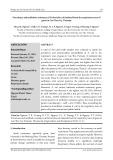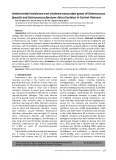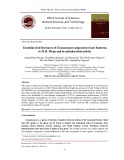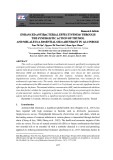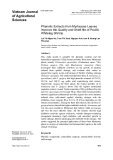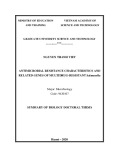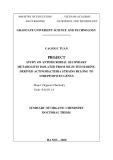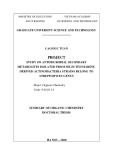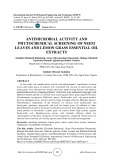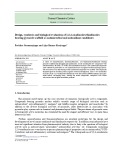VEGF gene expression is regulated post-transcriptionally in macrophages Min Du1, Kristen M. Roy1, Lihui Zhong1, Zheng Shen1, Hannah E. Meyers1 and Ralph C. Nichols1,2,3
1 Department of Microbiology and Immunology, Dartmouth Medical School, Hanover, NH, USA 2 Veterans Administration Research Service, White River Junction, VT, USA 3 Department of Medicine, Dartmouth Medical School, Hanover, NH, USA
Keywords VEGF; mRNA stability; 3¢ UTR; AURE; macrophage
Correspondence R.C. Nichols, Mailstop 151, Veterans Administration Research Service, 215 North Main Street, White River Junction, VT 05009-0001, USA Fax: +1 802 296 6308 Tel: +1 802 295 9363 extn 5891 E-mail: ralph.c.nichols@dartmouth.edu
(Received 4 April 2005, revised 12 December 2005, accepted 16 December 2005)
doi:10.1111/j.1742-4658.2006.05106.x
The macrophage is critical to the innate immune response and contributes to human diseases, including inflammatory arthritis and plaque formation in atherosclerosis. Vascular endothelial growth factor (VEGF) is an angio- genic cytokine that is produced by macrophages. To study the regulation of VEGF production in macrophages we show that stimulation of mono- cyte-macrophage-like RAW-264.7 cells by lipopolysaccharide (LPS) increa- ses expression of VEGF mRNA and protein. Three alternative splicing VEGF mRNA isoforms are produced, and the stability of VEGF mRNA increases following cellular activation. To study post-transcriptional regula- tion of the VEGF gene the 3¢-untranslated region (3¢ UTR) was introduced into the 3¢ UTR of the luciferase gene in a reporter construct. In both the 3¢ UTR RAW-264.7 cells and thioglycollate-elicited macrophages, sequence dramatically reduces reporter expression. Treatment with activa- tors of macrophages, including LPS, lipoteichoic acid, and VEGF protein, stimulates expression of 3¢ UTR reporters. Finally, mapping studies of the 3¢ UTR of VEGF mRNA show that deletion of the heterogeneous nuclear ribonucleoprotein l binding site affects basal reporter expression in RAW- 264.7 cells, but does not affect reporter activation with LPS. Together these results demonstrate that a post-transcriptional mechanism contributes to VEGF gene expression in activated macrophage cells.
joint
(2) neo-vascularization induced by VEGF contributes [11,12] and other to disease in the inflamed joint inflammatory diseases [13]; (3) macrophages express VEGFR-1 (Flt-1) and respond to VEGF protein [14]. To better understand the contribution of VEGF to inflammatory disease we investigated regulation of VEGF gene expression in macrophages.
several
The angiogenic cytokine vascular endothelial growth factor (VEGF) is associated with macrophage cell infil- tration in inflammation. Both VEGF and macrophage cells play a critical role in inflammatory processes including synovial inflammation [1–3], athero- sclerosis [4], tumorigenesis [5], nephritis [6], corneal [7] and diabetic [8] neovascularization. The relationship between macrophages and VEGF protein is important to the inflammatory response for reasons: (1) macrophages produce VEGF protein [9,10];
The relationship between macrophage activation and VEGF has been poorly explored in part because the macrophage cell expresses the VEGFR-1 receptor but
Abbreviations AURE, adenosine-uridine-rich element; CAURE, cytidine-adenosine-uridine-rich element; CSD ⁄ PTB, cold shock domain ⁄ polypyrimidine tract binding protein; GAPDH, glyceraldehyde-3-phosphate dehydrogenase; GLUT1, glucose transporter-1; hnRNP, heterogeneous nuclear ribonucleoprotein; HuR, ELAV protein HuA; hVEGF, human vascular endothelial growth factor; LPS, lipopolysaccharide; LTA, lipoteichoic acid; mVEGF, mouse vascular endothelial growth factor; TG-Mac, thioglycollate-elicited macrophages; TNFa, tumor necrosis factor-alpha; UTR, untranslated region.
FEBS Journal 273 (2006) 732–745 ª 2006 FEBS No claim to original US government works
732
M. Du et al.
Post-transcriptional regulation of VEGF in macrophages
(low kinase activity)
reverses
not the VEGFR-2 (Flk-1) receptor [14]. The VEGFR-1 receptor has been considered a decoy receptor on endothelial cells where VEGFR-1 is considerably less active than VEGFR-2 [15]. However, critical new reports show that the blockade of VEGFR-1, but not VEGFR-2, joint destruction in the K ⁄ BxN mouse model of arthritis [16,17]. In separate studies we show that the VEGFR-1 is upregulated in activated macrophages receptor (K. Roy, R. Fava, R.C. Nichols, unpublished data), suggesting that macrophages both produce and respond to VEGF in inflamed tissues. Although an autocrine suggested, mechanism of macrophage activation is VEGFR-1 is also the target of placental growth factor [17], and the role of VEGF in macrophage stimulation is not fully understood.
[18], and post-transcriptional
8. Three PCR products are produced from cDNA iso- lated from RAW-264.7 cells (Fig. 1A). These PCR products were sequenced and show that RAW-264.7 cells produce three VEGF isoforms, VEGF188, VEGF164 (exon 6 skipped), and VEGF120 (exons 6 and 7 skipped). The same isoforms were expressed by thioglycollate-elicited macrophages (TG-mac) from C3H ⁄ HeN cells (data not shown). The VEGF120 isoform is the most abundant PCR product. The PCR reaction is more efficient for smaller PCR products and the abundance of the smallest VEGF isoform may reflect this. In separate experiments we found that immunoblotting of whole-cell RAW-264.7 lysates with anti-VEGF antibody did not detect VEGF pro- tein (data not shown), suggesting that most of the VEGF protein is not cell associated and is exported in experiments where from macrophages. Finally, RAW-264.7 or thioglycollate-elicited macrophages were stimulated, the VEGF mRNA levels of all three isoforms increased but the relative amount of each isoform did not change, suggesting that alternative splicing of VEGF mRNA is not affected by cellular activation.
Effects of stimulation of RAW-264.7 cells on VEGF protein
(3.1 ± 0.6-fold
Regulation of VEGF gene expression is controlled by both transcriptional and post-transcriptional mech- anisms regulation is responsible for a major increase in VEGF production under hypoxia [18–25]. Post-transcriptional regulation is mediated by mRNA binding proteins that act on defined cis-acting elements, usually found in the 3¢-un- translated region (3¢ UTR) of the targeted mRNA [26,27]. Several reports have identified cis elements in the 3¢ UTR of VEGF mRNA that are recognized by heterogeneous nuclear ribonucleoprotein (hnRNP) L [25], ELAV protein HuA (HuR) [23] and the cold shock domain ⁄ polypyrimidine tract binding protein (CSD ⁄ PTB) complex [28]. To extend these studies, we now show that the 3¢ UTR of VEGF mRNA plays a role in VEGF gene expression in mouse macrophages under inflammatory conditions. We have introduced the 3¢ UTR of mouse VEGF (mVEGF) into the 3¢ UTR of the luciferase reporter gene and show that reporter activity increases when cells are treated with lipoteichoic acid (LTA) or lipopolysaccharide (LPS), the 3¢ VEGF protein. Finally, mapping studies of UTR suggests that the proximal region of the 3¢ UTR contains cis elements important in activated macro- phage cells. Together, these findings demonstrate that VEGF gene expression in macrophages is controlled by a post-transcriptional mechanism.
Results
Macrophage-like RAW-264.7 cells produce three VEGF isoforms
Alternative splicing of VEGF mRNA produces mul- tiple VEGF isoforms [29]. To determine which iso- forms are produced in macrophage cells we designed PCR primers homologous to sequences in exons 5 and
Rheumatoid tissue is populated by macrophages, and these cells produce VEGF mRNA and protein [1]. To show that stimulated RAW-264.7 cells increase pro- duction of VEGF we plated cells overnight, and then treated cells with the Toll-like receptor-4 activator LPS (100 ngÆmL)1) in fresh media for 4 h. Levels of VEGF protein in culture media were measured by ELISA. As shown in Fig. 1B, VEGF production increased by 60% with LPS treatment. Treatment of RAW-264.7 cells with tumour necrosis factor-a (TNFa) also increased increase with VEGF production 10 ngÆmL)1 TNFa for 4 h; mean ± SD for four experi- ments). Finally we measured the effects of human VEGF (hVEGF) on VEGF production by RAW-264.7 cells. Human VEGF is cross-reactive with mouse anti- bodies (R & D Systems, Minneapolis, MN) used for ELISA measurement. To correct for contaminating hVEGF, parallel wells of were treated with cyclohexi- mide (CHX), as described in Experimental procedures. Cells were treated overnight without or with VEGF protein (2 lgÆmL)1), media was replaced with media not containing hVEGF protein, and mVEGF was measured in the media after 4 h. As shown in Fig. 1C, treatment with hVEGF (NCI Clinical Repository, Frederick, MD) protein stimulated de novo protein synthesis fivefold.
FEBS Journal 273 (2006) 732–745 ª 2006 FEBS No claim to original US government works
733
M. Du et al.
Post-transcriptional regulation of VEGF in macrophages
Effects of stimulation of RAW-264.7 cells on VEGF mRNA
We next measured the effects of cellular activation on levels of endogenous VEGF mRNA and on the stabil- ity of VEGF mRNA. Lipopolysaccharide activates Toll-4 receptor; RAW-264.7 cells were untreated or treated with LPS (100 ngÆmL)1 for 4 h) and mRNA shown in levels were measured by RT ⁄ PCR. As Fig. 2A, levels of endogenous VEGF mRNA increased by 45% in cells treated with LPS. To evaluate whether VEGF mRNA was stabilized following LPS treatment,
in the 3¢ UTR in other cell
A
RAW-264.7 cells were treated with LPS for 4 h fol- lowed by no treatment or treatment with Actinomycin D for 1 or 2 h. The levels of VEGF mRNA were determined by RT ⁄ PCR and normalized to 18S rRNA. We found that the half-life of VEGF mRNA was increased in activated cells (Fig. 2B). The estimated mRNA half-lives at 2 h were 0.86 h (untreated) and 1.6 h (LPS treated). This finding is comparable to the 45 min half-life of VEGF mRNA reported in unstimu- lated monocyte-derived macrophages [30]. This result shows that mRNA stabilization is one mechanism that increases VEGF production in stimulated macro- phages. The stability of VEGF mRNA is affected by cis elements types [19,23,25,28,31] and we next tested the activity of AU-rich elements in macrophage cells.
Effects of AU-rich sequences on reporter activity in macrophages
B
Post-transcriptional regulation is mediated by mRNA binding proteins that act on cis elements in the 3¢ UTR [26–28,32]. Previous studies have shown that both AU-rich elements (AURE) and non-AURE ele- ments are active in the regulation of VEGF [19,23, 25,31]. To study AURE we created the AUUUA-luc luciferase reporter that contains a 30-nt sequence with multiple tandem repeats of the AUUUA pentamer and includes six overlapping UUAUUUAUU nonamers. Four hours after transfection in RAW-264.7 cells, the activity of the AUUUA-luc reporter was 75% less than the parent reporter pGL3 (Fig. 3). The activity of a control reporter (AUGUA-luc), in which guanosine
C
Fig. 1. Production of VEGF by RAW-264.7 cells. (A) VEGF isoforms. Primers specific to exons 5 and 8 were designed to amplify all known mouse VEGF alternative splice isoforms from cDNA. The PCR products for three isoforms (VEGF188, VEGF164, VEGF120) were found. Bars show DNA size standards. (B) Effects of LPS on VEGF protein production. To measure VEGF production, RAW- 264.7 were untreated or treated in fresh media for 4 h with LPS (100 ngÆmL)1). Levels of VEGF protein (mean ± SD; P < 0.03) were measured in the media from triplicate wells by ELISA. Results are from one of two experiments with similar results. (C) Effects of human VEGF protein on de novo VEGF protein production. To measure the effects of human VEGF on VEGF production, RAW- 264.7 were untreated or treated with human VEGF (2 lgÆmL)1) overnight. Medium was replaced with fresh media without VEGF, and levels of VEGF protein (mean ± SD; P < 0.02) were measured in the media from triplicate wells by ELISA. To correct for contami- nating hVEGF, parallel wells were treated with CHX (20 lM), as described in Experimental procedures. Results are from one of two experiments with similar results.
FEBS Journal 273 (2006) 732–745 ª 2006 FEBS No claim to original US government works
734
M. Du et al.
Post-transcriptional regulation of VEGF in macrophages
A
The effects of the 3¢-untranslated region of mouse VEGF mRNA on gene expression in a heterologous reporter
B
cotransfected TG-Mac
We evaluated the role of the 3¢ UTR in gene exp- ression by introducing the SmaI ⁄ XbaI fragment (nt 209–1747) of the mouse 3¢ UTR into the 3¢ UTR of the luciferase gene. The structure of the full-length reporter (VEGF-FL-luc) and related 3¢ UTR reporters is shown in Fig. 4A. The VEGF-FL-luc reporter con- tains all regulatory elements (or homologous regions) reported in rat, mouse, and hVEGF 3¢ UTR. The identified by Dibbens native polyadenylation signal et al. [34] was removed, and we used the more efficient bovine growth hormone poly(A) signal [35] present in the pcDNA-3.1 reporter construct. The poly(A) sequence and poly(A) binding protein mediate transla- tion of mRNA, and are not thought to affect mRNA stability [36–38]. Further studies are needed to deter- mine if the native poly(A) signal affects VEGF mRNA stability. We transfected the parental reporter (3.1-luc) or the VEGF-FL-luc reporter into nonactivated cells and measured luciferase levels after 4 h. The basal level of expression of the full-length 3¢ UTR reporter was dramatically less than that of the parent vector in both RAW-264.7 cells (80% reduction) and in TG-Mac cells (65% reduction) (Fig. 4B and C). Well- to-well variation was large in primary TG-Mac cells. Therefore, we cells with sea pansy luciferase (renilla) and we express these results as ‘normalized luciferase units.’ Together, these results demonstrate that the 3¢ UTR of VEGF mRNA inhibits expression of a heterologous reporter gene in macrophages.
Effects of the 3¢ UTR of VEGF mRNA on luciferase reporter mRNA levels
Fig. 2. Effects of macrophage activation on VEGF mRNA. (A) VEGF mRNA levels. RAW-264.7 cells were not treated or treated with LPS for 4 h and VEGF mRNA levels determined by RT ⁄ PCR. The levels of the three VEGF isoform PCR products from each sample were combined, and the sum was normalized to the level of 18S rRNA PCR product from the same sample. Results are relative val- ues, three samples per condition (mean ± SD; P < 0.04) and are representative of two experiments. (B) Half-life determination of VEGF mRNA. Decay of VEGF mRNA was measured in cells not- treated or treated with actinomycin D for 1 or 2 h. Levels of VEGF PCR products were normalized to levels of 18S rRNA from the same sample. Results are set to unity for the zero time point, and the mean ± SD of triplicate determinations are shown. VEGF mRNA levels at 2 h were significantly less than at zero hour (untreated, P < 0.005; LPS treated, P < 0.002). VEGF mRNA levels were significantly greater in LPS-treated samples than in untreated samples at 2 h (P < 0.015).
and measured
to note that
residues were substituted for uridine residues in each pentamer, was only 10% less than the parent con- struct. The 30-nt AURE from glucose transporter-1 (AURE ⁄ GLUT1-luc) [33], which contains no AUUUA pentamers, was 85% less than the parent reporter. These results show that both AUUUA and non- AUUUA AURE elements are active in RAW-264.7 cells. The 3¢ UTR of VEGF mRNA contains AURE and we next tested the activity of the full-length 3¢ UTR using reporter constructs.
Regulation by cis elements in the 3¢ UTR can affect mRNA levels or may affect translational efficiency [39]. To determine how the introduction of the 3¢ UTR of VEGF mRNA affected luciferase mRNA lev- els, we transfected RAW-264.7 cells with either the parental reporter, 3.1-luc, or the VEGF-FL-luc repor- ter luciferase mRNA levels by RT ⁄ PCR. As shown in Fig. 4D, luciferase mRNA was reduced by 40% in cells expressing the VEGF-FL-luc as compared to the parental luciferase mRNA. It is the parental 3.1-luc and important VEGF-FL-luc constructs are driven by the same pro- moter, and any differences between the luciferase mRNA levels are due to actions on the 3¢ UTR sequence of VEGF mRNA.
FEBS Journal 273 (2006) 732–745 ª 2006 FEBS No claim to original US government works
735
M. Du et al.
Post-transcriptional regulation of VEGF in macrophages
Fig. 3. AU-rich sequences reduce reporter activity. Sequences were introduced into the 3¢ UTR of the luciferase gene of the eukaryotic expression vector pGL3-Control (Promega). Luciferase activity was measured in cell lysates 4 h after transfection of RAW-264.7 cells. On the right are diagrams of the reporter constructs showing the nucleotide sequence of an artificial AU-rich element (AUUUA), a negative con- trol (AUGUA) and the non-AUUUA AURE identified in the 3¢ UTR of GLUT1 mRNA (AURE ⁄ GLUT1) [33]. Error bars are SD. Results shown are representative of five experiments. Results from cells transfected for 24 h were similar (data not shown).
VEGF protein on activation of VEGF-FL-luc reporter activity.
Effects of agents that activate macrophages on VEGF-FL-luc reporter activity
Macrophage cells express
of
recombinant
hVEGF for
greater
than
hVEGF treated,
We show in Fig. 1 that stimulated macrophages increase production of VEGF mRNA and protein. We next tested the effects of macrophage activating agents on VEGF-FL-luc reporter activity in RAW-264.7 cells. Dose–response treatment with LPS showed that repor- ter activity was maximal with 100 ngÆmL)1 (1.82 ± untreated, mean ± SD). 0.25-fold Reporter activity increased for up to 6 h and did not increase further after 24 h (data not shown). Because LPS acts on the Toll-4 receptor, we next determined if the Toll-2 receptor ligand, LTA [40], could affect the VEGF-FL-luc reporter activity. When RAW-264.7 cells were treated with LTA (1 lgÆmL)1, 24 h), VEGF- FL-luc reporter activity increased 1.69 ± 0.17-fold over untreated controls. Next, we tested the effects of
the VEGFR-1 (Flt-1) receptor [41] and macrophages migrate in response to VEGF protein at levels as low as 12 ngÆmL)1 [14]. To determine if VEGF protein affects RAW-264.7 cells, we first measured production of a primary marker of macrophage activation, TNFa. Cells treated with 100 ngÆmL)1 24 h increased TNFa production by 9.3 fold (untreated, 1359 ± 186 pgÆmL)1: 12 604 ± 3461 pgÆmL)1; mean ± SD). We next measured the effects of hVEGF on VEGF-FL-luc reporter expres- sion in RAW-264.7 cells. Treatments with hVEGF as low as 3.3 ngÆmL)1 increased reporter activity with maximal activity seen at 100 ngÆmL)1 (2.2 ± 0.2 fold increase over untreated; mean ± SD). Effects of acti- vating agents on VEGF-FL-luc reporters are normal-
[23], and the CSD ⁄ PTB binding site (nt 1727–39)
Fig. 4. The effects of the 3¢ UTR of VEGF mRNA on reporter expression in macrophages. (A) Diagram of mVEGF reporter constructs. Upper-most bar shows the 3¢ UTR region studied. Adenosine-uridine-rich (AU) and cytidine-adenosine-uridine-rich (CAU and CSD ⁄ PTD) regions are noted. The parent construct, 3.1-luc, was created as described in Experimental procedures. The full-length reporter (VEGF-FL-luc) construct contains nt-209–1747 of the 3¢ UTR of mVEGF mRNA, and the sequence is shown below. The CAURE site recognized by hnRNP L (nt 322–342), the CAURE recognized by HuR (nt 1622–1665) [28] are shown in bold ⁄ underlined type. Additional AU-rich sequences, including all AUUUA pentamers and nonomers, are shown in bold type. Engineering of reporter constructs is described in Experimental procedures. (B, C) The 3¢ UTR of VEGF mRNA suppresses reporter activity in macrophages. The effects on reporter activity of the 3¢ UTR of VEGF mRNA were measured in untreated macrophage cells by transfection of either the control reporter construct (3.1-luc) or the full-length VEGF-3¢ UTR reporter (VEGF-FL-luc). RAW-264.7 cells (B) or TG-Mac cells from C3H ⁄ HeN mice (C) were lysed 4 h after transfection, and luciferase activity was read by luminometry. Similar results were seen after 24 h (data not shown). Diagrams on the right show the construct used to transfect cells. Data are the mean ± SD, and are representative of at least three experiments. (D) Luciferase mRNA levels. RAW-264.7 cells were transfected with the parent vector (3.1-luc) or with VEGF-FL-luc for 24 h. Total RNA was prepared from cell cytoplasm and RT ⁄ PCR was performed with luciferase primers or GAPDH primers as described in Experimental procedures.
FEBS Journal 273 (2006) 732–745 ª 2006 FEBS No claim to original US government works
736
M. Du et al.
Post-transcriptional regulation of VEGF in macrophages
(see Experimental procedures,
of bacterial origin (LPS, LTA) and endogenous origin (VEGF) increase VEGF 3¢ UTR-dependent reporter expression. In addition, these results show that the reporter construct is a useful tool for mapping the 3¢ UTR.
ized to parent reporter levels in cells treated in an iden- tical manner and Fig. 6). Treatment with hVEGF produced maximal VEGF-FL-luc reporter activity in 4 h, with longer times (up to 24 h) showing similar increases. Together, these results demonstrate that pro-inflammatory agents
A
B
D
C
FEBS Journal 273 (2006) 732–745 ª 2006 FEBS No claim to original US government works
737
M. Du et al.
Post-transcriptional regulation of VEGF in macrophages
Fig. 5. Mapping of the 3¢ UTR from VEGF mRNA. Reporter constructs were created that separated the proximal and distal regions of the 3¢ UTR from VEGF mRNA (see Fig. 4A). The reporter VEGF-209–750-luc contains the proximal region (nt 209–750). The reporter VEGF-751– 1747-luc contains the distal region (nt 751–1747). Reporter constructs were transfected into RAW-264.7 cells and luciferase activity meas- ured in cell lysates after 4 h. Similar results were seen at 24 h (data not shown). Results are mean ± SD and are representative of five independent experiments.
Mapping of the 3¢ UTR of VEGF mRNA
(1)
increases
the proximal
that contain either
CAU) from the full-length reporter. As shown in Fig. 6, deletion of the hnRNP L element (VEGF-dL- luc) reduced reporter activity by 25% in untreated RAW-264.7 cells (compare columns 1 and 3). In cells treated with LPS (100 ngÆmL)1), VEGF-FL-luc and VEGF-dL-luc responded with similar in reporter activity (VEGF-FL-luc increased 2.1-fold, VEGF-dL-luc increased 2.5-fold). Treatment of RAW- 264.7 cells with hVEGF protein produced similar effects on these reporters (data not shown). We con- clude that the hnRNP L element affects basal levels of VEGF reporter activity but does not affect increases in VEGF reporter found in activated cells. We are cur- rently extending this mapping analysis to identify addi- tional 3¢ UTR regulatory elements that are active in macrophages.
Discussion
the activity of
As shown in Fig. 4A, the 3¢ UTR of mVEGF mRNA is complex. The region proximal to the coding region contains a CAU-element [19,25] but no AUUUA pen- tamers. The distal region contains: two active CAU-rich elements [23,28]; and (2) six AUUUA pen- tamers and two nonomers, some of which are active [31]. To isolate these regions we created luciferase reporters region (VEGF-209–750-luc) or the distal region (VEGF-751– 1747-luc) (see Fig. 4A). When transfected into RAW- 264.7 cells, neither construct displayed the level of inhibition found with the full-length construct (Fig. 5). Although we cannot rule out the possibility that a cis element at nt 750 has been interrupted, this region contains no AU- or CAU-rich sequence motifs. The reporter activity of the proximal VEGF-209–750-luc construct was most similar to the full-length construct. the VEGF-209–750-luc In addition, reporter increased in LPS-treated cells whereas the VEGF-751–1747-luc was minimally affected by LPS treatment (data not shown). For this reason we exam- ined candidate elements in the proximal region of the 3¢ UTR.
suggesting that
The hnRNP L element
The VEGF cytokine plays a major role in cancer by controlling neo-vascularization in solid tumours [13]. In arthritis, VEGF stimulates vascularization that supports the ’tumour-like’ phenotype of the inflamed synovium [12]. However, VEGF also plays a role in vascular permeability and as a chemoattractant [11,12,14], the role of VEGF in inflamed joints may be complex. Macrophages in rheu- matoid joints produce VEGF [1], and we have found that VEGFR-1 is upregulated in activated macro- phages (K. Roy, R. Fava, R.C. Nichols, unpublished data). Together these facts suggest that macrophages at the site of inflammation both respond to VEGF and contribute to the inflammatory response by producing VEGF protein. In this report we confirm that macro-
Shih and Claffey identified a cis element in the prox- imal region of hVEGF that was recognized by the mRNA binding protein, hnRNP L [25]. The hnRNP L element is highly conserved between human and mouse and we used site-directed mutagenesis to delete the sequence (nt 322–42, CACCCACCCACAUACACA
FEBS Journal 273 (2006) 732–745 ª 2006 FEBS No claim to original US government works
738
M. Du et al.
Post-transcriptional regulation of VEGF in macrophages
Fig. 6. The effects of the hnRNP L element on reporter activity. To test the activity of the cis element recognized by hnRNP L [25], the sequence (CACCCACCCACAUACACACAU) was deleted from the full-length reporter construct. The deletant reporter, VEGF-dL-luc, produced less activity in untreated RAW-264.7 cells (compare columns 1 and 3). In macrophages treated with LPS (100 ngÆmL)1 for 24 h), both the VEGF-FL-luc and VEGF-dL-luc reporters showed similar increases in reporter activity. Treatment with LPS affects the promoter of the repor- ter construct. To account for this effect, luciferase units (mean ± SD) are normalized to luciferase units of the 3.1-luc parental construct trea- ted in parallel wells. For example, the reporter values without LPS treatment were: 3.1-luc, 693 000 ± 97 000 luc units; VEGF-FL-luc, 104 000 ± 4000 luc units. Reporter values with LPS treatment were: 1157 000 ± 16 000 (3.1-luc) and 369 000 ± 24 000 (VEGF-FL-luc). The normalized value for VEGF-FL-luc reporter activity is set at unity (column 1).
phages respond to VEGF and other inflammatory mediators by increasing VEGF production. We also show that macrophages produce multiple mRNA VEGF isoforms, and the stability of VEGF mRNA increases in activated cells. We demonstrate that macro- phage activation increases expression of VEGF luci- ferase reporters containing the mouse VEGF 3¢ UTR region, and we present mapping analysis of the VEGF 3¢ UTR. Together, these results demonstrate that, as in cancer models, VEGF expression is controlled at the post-transcriptional level in macrophage-like cells.
expression in macrophage
To study regulatory cis elements in VEGF mRNA we introduced the 3¢ UTR of mVEGF mRNA into the 3¢ UTR of the luciferase gene in a reporter construct. Using this method, we can segregate post- transcriptional regulation from both transcriptional regulation of the native VEGF promoter, and post- translational regulation acting on the VEGF pro- tein. We show in both monocyte-macrophage-like RAW-264.7 cells and thioglycollate-elicited macro- phages that introduction of the full-length 3¢ UTR construct significantly reduced luciferase mRNA levels, and reduced basal reporter activity (Fig. 4B, C, D). Next, we show that, under conditions in which VEGF mRNA is stabilized (LPS activation), luciferase repor- ter activity increased. These results suggest that the 3¢ UTR in VEGF mRNA contributes to the increases in VEGF mRNA and protein found when macrophages are stimulated. We are the first to show that the 3¢ expression UTR of VEGF mRNA affects gene in macrophages.
Post-transcriptional regulation of mRNA is medi- ated by mRNA binding proteins that recognize cis-act- ing elements, most frequently found in the 3¢ UTR region [26–28]. The most studied cis-acting elements are AURE. Analysis of the human genome estimates that 8% of human mRNAs contain AURE [42]. Three classes of AURE have been identified [26,27], and the 3¢ UTR of VEGF mRNA contains two of these AURE classes: (a) Class I, nonoverlapping AUUUA
Increased production of VEGF has been shown to act by both transcriptional and post-transcript- ional mechanisms [13]. Post-transcriptional regulation involves mRNA binding proteins acting on cis ele- ments to alter mRNA stability or the efficiency of translation [32]. Post-transcriptional regulation affects VEGF production in a cancer model [18], but it is unclear whether post-transcriptional regulation affects VEGF gene cells. To address this, we show here that under conditions in which VEGF protein production increases: (a) VEGF increased (Fig. 2A); and (b) VEGF mRNA levels mRNA stability increased (Fig. 2B). However, these increases in VEGF mRNA and protein production may also result in part from increased transcription. We are currently assessing transcriptional regulation in activated macrophages, and only report here studies of 3¢ UTR-mediated regulation.
FEBS Journal 273 (2006) 732–745 ª 2006 FEBS No claim to original US government works
739
M. Du et al.
Post-transcriptional regulation of VEGF in macrophages
AURE luciferase reporter, which is also a long non- AUUUA Class III, was very active in RAW-264.7 cells (Fig. 3). Future studies will determine if this AURE or other noncanonical cis elements in the proximal region contribute to 3¢ UTR-dependent regulation in macro- phages.
A/U nonamers; pentamers and UUAUUUAA/U (b) Class rich and uridine-rich III, adenosine-uridine sequences that lack AURE pentamers. Several reports have analysed AU-rich elements in rat and human VEGF 3¢ UTR [19,21–23,43–44]. One Class III AURE element that was identified in rat VEGF is not con- served in mouse or human [20]. Another type of cis element, that we refer to as a CAU-rich element (CAURE), contains adenosine, uridine and cytidine residues, and CAURE have been identified in GLUT1 mRNA [45] (nt 2180–90) and in the 3¢ UTR of VEGF mRNA [23,25,28,46]. The hnRNP L binding site (nt 322–342) [25], HuR binding site (nt 1622–1665) [23,46], and CSD ⁄ PTB complex binding site (nt 1727– 39) [28] in the 3¢ UTR of VEGF mRNA are CAU- rich. Here we present our analysis of 3¢ UTR-mediated regulation in mouse macrophage cells.
Three agents that stimulate macrophages (LPS, LTA and VEGF) increased VEGF 3¢ UTR-dependent repor- ter activity. One mechanism we considered was that these agents act by initially stimulating production of TNFa, and then TNFa stimulates VEGF gene expres- sion. To investigate this, we first showed that LPS sti- mulated production of TNFa (data not shown). Next we determined whether TNFa affected VEGF 3¢ UTR- dependent reporter activity. Although TNFa treatment increased VEGF protein production, we found that TNFa treatment decreased VEGF-FL-luc reporter activity modestly but significantly ((cid:1)10%; data not shown). We conclude that post-transcriptional stimula- tion of VEGF gene expression by agents such as LPS and VEGF do not act through TNFa by an autocrine mechanism.
(ii)
(iii)
The 3¢ UTR of mVEGF mRNA contains cis ele- ments regions in both the proximal and distal [21,22,25,43,47]. The distal two-thirds of the mouse 3¢ UTR contains six AURE pentamers, two nonomers, two CAURE and seven additional regions of 10 or more AU nucleotides that lack AUUUA pentamers. Several groups have shown that cis elements in the distal region have strong affects on VEGF gene expression under hypoxic stress [22,46]. Under norm- oxia these distal cis elements contribute to VEGF mRNA instability. It was surprising therefore to find that when the distal region of the 3¢ UTR was removed (to create VEGF-209–750-luc) reporter activ- ity was similar to that of the full-length reporter (Fig. 5). In addition, cells stimulated with LPS or with VEGF showed increased VEGF-209–750-luc reporter activity. In contrast, the VEGF-751–1747-luc reporter responded poorly to cellular activation (data not shown), suggesting that regulatory elements active in macrophages reside in the proximal region of the VEGF 3¢ UTR.
The proximal region of
(data not
Activation of VEGF gene expression in RAW-264.7 cells with LPS and VEGF was distinct from treatments with TNFa. Treatment with TNFa decreased reporter activity and increased VEGF protein production. Treatment with LPS or with VEGF protein increased both reporter activity and VEGF protein production. However, the effect of LPS on VEGF protein produc- tion was modest compared to the effects of VEGF treatment. These different profiles of VEGF gene regulation by TNFa, VEGF and LPS may result from different gene activation mechanisms. Our results suggest that: (i) TNFa stimulates VEGF production inhibits by a transcriptional mechanism, but the post-transcriptional treatment with pathway; VEGF stimulates both transcriptional and post-tran- treatment with LPS acts scriptional pathways; solely through a post-transcriptional mechanism, and does not affect VEGF transcription. Studies of the effects by these agents on transcription are on going. If LPS acts solely by a post-transcriptional mechanism, then long-term studies are needed to determine if the modest effects by LPS result in sufficient production of VEGF to initiate VEGF-driven autocrine production of VEGF. Importantly, our results suggest that post- transcriptional regulation of VEGF may be important under conditions in which TNFa is not active, inclu- ding under therapeutic conditions where TNFa action is blocked.
the 3¢ UTR contains a CAURE in hVEGF that is recognized by hnRNP L under both normoxic and hypoxic conditions in M21 melanoma cells [25]. The homologous mouse sequence is nearly identical to the human CAURE, and deletion of the hnRNP L element resulted in a decrease in reporter activity in untreated RAW-264.7 cells. How- ever, the activity of the wild-type and VEGF-dL-luc reporters both increased in cells treated with LPS (Fig. 6). Treatment with hVEGF produced similar results shown). Although there are no AUUUA pentamers in the nt 209–750 region there is a long AU-rich region (78-nt, 97% adenosine-uridine) that is tandem to the hnRNP L element. This AURE the GLUT1- is interesting because we found that
Originally identified as a permeability factor, VEGF is now known to play an essential role in arterio- genesis [13], neo-vascularization in cancer [13], and
FEBS Journal 273 (2006) 732–745 ª 2006 FEBS No claim to original US government works
740
M. Du et al.
Post-transcriptional regulation of VEGF in macrophages
parallel wells were not treated ⁄ treated with activating agent in an identical manner as wells transfected with VEGF reporters. To account for effects on the construct promoter, results were normalized to the parental luciferase values. Thioglycollate-elicited macrophages
inflammatory diseases [12]. Our studies with macroph- ages demonstrate that the 3¢ UTR of VEGF contri- butes to gene expression and provides a novel target to treat active disease. Post-transcriptional regulation of VEGF in macrophages is mediated by the action of VEGF on its cognate receptor, VEGFR-1. Regulation of VEGF by an autocrine mechanism in cancer has been reviewed [48]. It is possible that VEGF and its receptor interact intracellularly to regulate VEGF gene expression [48]. The mechanism of regulation of the macrophage VEGF receptor, VEGFR-1, is now under study to determine if VEGF protein and its receptor are coordinately regulated.
Experimental procedures
(TG-Mac) were obtained from C3H ⁄ HeN mice as previously described [49]. Briefly, mice were injected with thioglycollate and after 3 days, mice were killed by cervical dislocation. Macrophages were removed from the peritoneum and plated on 6- or 48-well tissue culture plates and main- tained in the same media used for RAW-264.7 cells. Nonadherent cells were removed after 24 h. The well-to- well efficiency of transfection of primary TG-Mac was monitored in reporter assays by cotransfection of pRL- SV40 renilla luciferase. Reporter activity was normalized to the value of renilla luciferase for each experimental condition.
Cell culture, transfection and luciferase assay
All experimental procedures were carried out in accor- dance with NIH guidelines regarding the care and use of experimental animals.
Measurement of VEGF and TNFa production by ELISA
transfection, plasmid DNA was
treated or
collected. To account for
The RAW-264.7 cell line was obtained from ATCC (Manassas, VA) and maintained as described. Media was DMEM supplemented with 10% heat-inactivated fetal bovine serum (Hyclone, Logan, VT) and penicillin-strep- tomycin. Cultured cells were plated 24 h prior to trans- fection in six-well or 48-well plates. Cells were adherent and were transfected at 40% confluence in Opti-MEM media (Invitrogen-Gibco, Carlsbad, CA) with luciferase constructs (plasmid constructs are described below). For cell complexed with Lipofectamine-2000, as described by the manufacturer (Invitrogen-Gibco). Cells in 48-well plates were lysed with 100 lL cell culture lysis reagent lysis buffer (Promega). After 4 or 24 h, luciferase activity in 20 lL of lysate was measured following addition of luciferin substrate (Prome- ga, Madison, WI) in a Molecular Dynamics luminometer. Each transfection condition in 48-well plates was per- formed in six wells. Two wells were pooled (10 lLÆwell)1) to give triplicate readings for each experimental condi- tion. Results are reported as the mean ± SD. All experi- two or more independent ments are representative of experiments performed on different days. The efficiency of transfection in RAW-264.7 cells was evaluated by co- transfection with renilla luciferase (pRL-SV40 Promega). Cells in 48-well plates were transfected with 0.1 lg luci- ferase and 0.01 lg renilla luciferaseÆwell)1 and lysed in Dual-Glo lysis buffer (Promega). The well-to-well vari- ation of firefly luciferase activity in RAW-264.7 cells was not improved by normalization to renilla luciferase.
FEBS Journal 273 (2006) 732–745 ª 2006 FEBS No claim to original US government works
741
The effects of LPS, TNFa and hVEGF on mVEGF pro- tein production was measured in cells plated 24 h before treatment. After treatment, medium was collected and stored at )80 (cid:1)C. Cells were treated with LPS (generous gift of H. Yohe, Veterans Administration Research Service, White River Junction, VT) or human TNFa (gen- erous gift of R. Fava, Veterans Administration Research Service, White River Junction, VT). Human VEGF was produced in baculovirus by R & D Systems, and obtained from the NCI Clinical Repository. The activity of hVEGF was lost following boiling [50]. Production of mVEGF (mVEGF) was measured by ELISA (Mouse VEGF, #MMV00, R & D Systems). Due to small but significant cross-reactivity between mVEGF and hVEGF, we could not directly measure mVEGF production by cells treated with hVEGF. Therefore, production of mVEGF follow- ing stimulation with hVEGF was determined as follows. RAW-264.7 cells were not treated with 2 lgÆmL)1 hVEGF. After 24 h, cells were rinsed and incu- bated with fresh media (without VEGF), and after 4 h media were contaminating hVEGF, all treatments were performed in parallel, and these parallel wells were treated for 4 h with 20 lm CHX to block de novo protein synthesis. Levels of de novo VEGF protein was determined by subtracting VEGF lev- els in parallel CHX-treated wells. Similar results were found with hVEGF from another source (R & D Sys- tems). Production of mouse TNFa was measured in media by ELISA, according to the manufacturer’s directions (Mouse TNFa, #MTA00, R & D Systems). The effect of cell activation on 3¢ UTR reporter activity was measured by adding the activating agent (LPS, LTA, or human VEGF) 2 h after transfection and cells were lysed 4 or 24 h later. In some experiments with macrophage acti- vating agents the cell treatment affected the promoter of the reporter construct. In these experiments parallel wells were transfecting with the parental (empty) reporter. The
M. Du et al.
Post-transcriptional regulation of VEGF in macrophages
Plasmid construction
VEGF 3¢UTR luciferase reporter constructs
[33]
the luciferase gene from pGL3 (Promega)
Control (Promega). The AURE ⁄ GLUT1-luc construct con- tains the AU-rich sequence from the 3¢ UTR of human glu- cose transporter-1 (GLUT1) (5¢-UUUUAUAAUU UUUUUAUUACUGAUUUUGUU-3¢ nt 1885–1914; Gen- Bank #K03195). The AURE ⁄ GLUT1-luc construct was created by site-directed mutagenesis (QuickChange, Strata- gene) of the AUUUA-luc construct.
Obtaining RNA
Total RNA was obtained using RNeasy (Qiagen). The quantity and quality of RNA were determined spectropho- tometrically at 260 and 280 nm and by analysis on forma- mide agarose gels.
RT/PCR
signal
element [25] using PCR-based
The parental luciferase vector was created by introduction into the of multiple cloning site of pcDNA-3.1 (Invitrogen, Carlsbad, CA) to create 3.1-luc. The 1549-bp SmaI ⁄ XbaI fragment of the 3¢ UTR from mVEGF was released from the Sma4 plasmid (generously provided by Pat D’Amore, Harvard University) and cloned into the 3¢ UTR of the luciferase gene of 3.1-luc. The VEGF-FL-luc construct contains nt 209–1747 of the mVEGF 3¢ UTR where nt 1 is the first base of the VEGF stop codon [34] (identical to bases 209–1747, GenBank #AF317892). The nt 1–208 region of the 3¢ UTR contains no AUUUA pentamers or other can- didate cis elements and was not included in the construct. The nt 1748–1894 region contains the only active mVEGF AUUAAA polyadenylation [poly(A)] signal, as described by Dibbens et al. [34], and was not included in reporter reporter constructs utilized the bovine constructs. All growth hormone poly(A) in the parent vector (pcDNA-3.1 vector). The XbaI ⁄ ApaI fragment that con- tained the poly(A) signal was shown by others to not affect mRNA stability [22]. Construct VEGF-209–750-luc the BamHI ⁄ XbaI fragment was created by deletion of from the VEGF-FL-luc construct. The VEGF-751– 1747-luc construct was created by deletion of the EcoRV ⁄ BamHI fragment from the VEGF-FL-luc construct. The VEGF-dL-luc construct was created by deletion of the hnRNP L cis-acting (CACCCACCCACAUA from the VEGF-FL-luc CACACAU nt 322–342) construct site-directed mutagenesis (QuickChange, Stratagene, La Jolla, CA). One nucleotide (C-388, underlined) in mouse is nonhomologous to human (human U-358, GenBank #AF024710). Following muta- genesis, the sequence of the VEGF-dL-luc was verified by sequencing on both strands and then cloned into a 3.1-luc parental vector that had not been subjected to PCR. The integrity of all plasmid constructs was verified by sequen- cing on both strands.
AURE luciferase constructs
Oligonucleotide PCR primers for mVEGF, mouse glyceral- dehyde-3-phosphate dehydrogenase (GAPDH), mouse 18S rRNA, and luciferase genes were designed using Primer3 [51]. To determine levels of luciferase mRNA, total RNA from the cytoplasmic fraction (as described in the RNeasy kit, Qiagen) was treated twice with DNase to remove con- taminating nuclear and plasmid DNA. Primers used to measure VEGF mRNA were specific for sequences in exon 5 (sense primer) and exon 8 (antisense primer). For each sample, cDNA was prepared from 1 lg of RNA using Superscript (Gibco) and PCR was performed on 10% of the cDNA in a 20-lL reaction using standard amplifying conditions with Supermix PCR cocktail (Gibco). We per- formed preliminary experiments to identify the range of PCR cycle reactions that produced linear increments of PCR product formation. We used the cycle number within this range that produced PCR products from all samples. VEGF and GAPDH PCR products were amplified from regions of mRNA that crossed exon junctions. Large PCR products resulting from genomic contamination were not found. All PCR products were cloned into pCR-II-Topo (Invitrogen) and sequenced on both strands. Sequences of all primers used in this report are available upon request. PCR products were stained with ethidium bromide, photo- graphed, scanned into photoshop, and quantified using nih image (http://rsb.info.nih.gov/nih-image/Default.html). Levels of VEGF mRNA are presented as the level of VEGF PCR products normalized to level of 18S rRNA PCR product from the same sample. Relative values are presented as mean ± SD of triplicate independent samples for each experimental condition.
Constructs
VEGF mRNA stability
FEBS Journal 273 (2006) 732–745 ª 2006 FEBS No claim to original US government works
742
Two constructs were created that contain AU-rich elements (AURE). The AUUUA-luc construct contains a 30-nt AU- rich sequence with pentamer repeats (5-AUUAUUUAUU UAUUUAUUUAUUUAUUUAUU-3¢). A control repor- ter (AUGUA-luc) was created in which AUGUA pentam- ers replaced AUUUA pentamers (5¢-AUUAUGUAUGUA UGUAUGUAUGUAUGUAUU-3¢). were created by designing complementary sense and antisense oligonucleotides with XbaI sites on the 5¢- and 3¢-ends. The oligonucleotides were annealed and cloned into the XbaI site in the 3¢ UTR of the luciferase gene in pGL3- Stability of mRNA was measured by not-treating (0 h) or treating cells with 5 lm actinomycin D for 1 or 2 h. Levels of VEGF mRNA in triplicate samples were deter-
M. Du et al.
Post-transcriptional regulation of VEGF in macrophages
mined by RT ⁄ PCR and normalized to levels of 18S rRNA PCR product in the same sample. Half-life of mRNA was calculated using the zero and two h time points. Actinomycin D treatment did not affect levels of 18S rRNA. 6 Shihab FS, Bennett WM, Isaac J, Yi H & Andoh TF (2002) Angiotensin II regulation of vascular endo- thelial growth factor and receptors Flt-1 and KDR ⁄ Flk-1 in cyclosporine nephrotoxicity. Kidney Int 62, 422–433.
Statistical analyses
7 Philipp W, Speicher L & Humpel C (2000) Expression of vascular endothelial growth factor and its receptors in inflamed and vascularized human corneas. Invest Ophthalmol Vis Sci 41, 2514–2522.
Data are presented for representative experiments that were repeated two or more times. Within each experi- ment, treatments were performed in triplicate, as indica- ted in the figure legends. Results were analysed by Student’s t-test. A P value of < 0.05 was taken to indi- cate significance. 8 Aiello LP, Avery RL, Arrigg PG, Keyt BA, Jampel HD, Shah ST, Pasquale LR, Thieme H, Iwamoto MA, Park JE et al. (1994) Vascular endothelial growth factor in ocular fluid of patients with diabetic retinopathy and other retinal disorders. N Engl J Med 33, 1480–1487.
Acknowledgements
9 Burke B, Giannoudis A, Corke KP, Gill D, Wells M, Ziegler-Heitbrock L & Lewis CE (2003) Hypoxia- induced gene expression in human macrophages: impli- cations for ischemic tissues and hypoxia-regulated gene therapy. Am J Pathol 163, 1233–1243.
technical We thank Xiao Wei Wang for excellent assistance. We also thank Herb Yohe for mouse macrophages and Pat D’Amore for the Sma4 plasmid containing the mouse VEGF 3¢UTR. We are very grateful to William Rigby and Roy Fava for advice and helpful discussions.
10 Xiong M, Elson G, Legarda D & Leibovich SJ (1998) Production of vascular endothelial growth factor by murine macrophages, regulation by hypoxia, lactate, and the inducible nitric oxide synthase pathway. Am J Pathol 153, 587–598. 11 Afuwape AO, Kiriakidis S & Paleolog EM (2002) The
role of the angiogenic molecule VEGF in the pathogen- esis of rheumatoid arthritis. Histol Histopathol 17, 961– 972.
This work was supported by a Merit Review Award (to R.C.N) from the Department of Veterans Affairs, and by National Institutes of Health Grants R03- AR47393 (to R.C.N) and P20RR16437 (to R.C.N) from the COBRE Program of the National Center for Research Resources.
12 Paleolog EM (2002) Angiogenesis in rheumatoid arthri- tis. Arthritis Res 4, S81–S90.
References
1 Fava RA, Olsen NJ, Spencer-Green G, Yeo KT, Yeo 13 Ferrara N (1999) Role of vascular endothelial growth factor in the regulation of angiogenesis. Kidney Int 56, 794–814.
TK, Berse B, Jackman RW, Senger DR, Dvorak HF & Brown LF (1994) Vascular permeability factor ⁄ endo- thelial growth factor (VPF ⁄ VEGF): accumulation and expression in human synovial fluids and rheumatoid synovial tissue. J Exp Med 18, 341–346. 14 Sawano A, Iwai S, Sakurai Y, Ito M, Shitara K, Naka- hata T & Shibuya M (2001) Flt-1, vascular endothelial growth factor receptor 1, is a novel cell surface marker for the lineage of monocyte-macrophages in humans. Blood 97, 785–791. 2 Firestein GS (2003) Evolving concepts of rheumatoid 15 Hiratsuka S, Maru Y, Okada A, Seiki M, Noda T & arthritis. Nature 423, 356–361.
3 Kinne RW, Brauer R, Stuhlmuller B, Palombo-Kinne E & Burmester GR (2000) Macrophages in rheumatoid arthritis. Arthritis Res 2, 189–202. Shibuya M (2001) Involvement of Flt-1 tyrosine kinase (vascular endothelial growth factor receptor-1) in pathological angiogenesis. Cancer Res 61, 1207– 1213.
4 Shibata M, Suzuki H, Nakatani M, Koba S, Geshi E, Katagiri T & Takeyama Y (2001) The involvement of vascular endothelial growth factor and flt-1 in the pro- cess of neointimal proliferation in pig coronary arteries following stent implantation. Histochem Cell Biol 116, 471–481. 16 De Bandt M, Ben Mahdi MH, Ollivier V, Grossin M, Dupuis M, Gaudry M, Bohlen P, Lipson KE, Rice A, Wu Y, Gougerot-Pocidalo MA & Pasquier C (2003) Blockade of vascular endothelial growth factor receptor I (VEGF-RI), but not VEGF-RII, suppresses joint destruction in the K ⁄ BxN model of rheumatoid arthri- tis. J Immunol 171, 4853–4859. 17 Luttun A, Tjwa M, Moons L, Wu Y, Angelillo-Scherrer
FEBS Journal 273 (2006) 732–745 ª 2006 FEBS No claim to original US government works
743
5 Hiratsuka S, Nakamura K, Iwai S, Murakami M, Itoh T, Kijima H, Shipley JM, Senior RM & Shibuya M (2002) MMP9 induction by vascular endothelial growth factor receptor-1 is involved in lung-specific metastasis. Cancer Cell 2, 289–300. A, Liao F, Nagy JA, Hooper A, Priller J, De Klerck B et al. (2002) Revascularization of ischemic tissues by PlGF treatment, and inhibition of tumor angiogenesis,
M. Du et al.
Post-transcriptional regulation of VEGF in macrophages
arthritis and atherosclerosis by anti-Flt1. Nat Med 8, 831–840. VEGF expression by oxidised LDL in human macro- phages. Eur J Clin Invest 32, 767–774. 31 Ciais D, Cherradi N, Bailly S, Grenier E, Berra E,
18 Levy AP, Levy NS, Wegner S & Goldberg MA (1995) Transcriptional regulation of the rat vascular endothe- lial growth factor gene by hypoxia. J Biol Chem 270, 13333–13340. Pouyssegur J, Lamarre J & Feige JJ (2004) Destabili- zation of vascular endothelial growth factor mRNA by the zinc-finger protein TIS11b. Oncogene 23, 8673–8680.
32 Tourriere H, Chebli K & Tazi J (2002) mRNA degra- dation machines in eukaryotic cells. Biochimie 84, 821–837. 33 Griffin ME, Hamilton BJ, Roy KM, Du M, Willson 19 Claffey KP, Shih SC, Mullen A, Dziennis S, Cusick JL, Abrams KR, Lee SW & Detmar M (1998) Identification of a human VPF ⁄ VEGF 3¢ untranslated region medi- ating hypoxia-induced mRNA stability. Mol Biol Cell 9, 469–481. 20 Goldberg-Cohen I, Furneaux H & Levy AP (2002) A
AM, Keenan BJ, Wang XW & Nichols RC (2004) Post- transcriptional regulation of glucose transporter-1 by an AU-rich element in the 3¢UTR and by hnRNP A2. Biochem Biophys Res Commun 318, 977–982. 40-bp RNA element that mediates stabilization of vas- cular endothelial growth factor mRNA by HuR. J Biol Chem 277, 13635–13640. 21 Levy AP, Levy NS & Goldberg MA (1996) Hypoxia-
34 Dibbens JA, Polyak SW, Damert A, Risau W, Vadas MA & Goodall GJ (2001) Nucleotide sequence of the mouse VEGF 3¢UTR and quantitative analysis of sites of polyadenylation. Biochim Biophys Acta 1518, 57–62. inducible protein binding to vascular endothelial growth factor mRNA and its modulation by the von Hippel- Lindau protein. J Biol Chem 271, 25492–25497. 35 Goodwin EC & Rottman FM (1992) The 3¢-flanking
sequence of the bovine growth hormone gene contains novel elements required for efficient and accurate poly- adenylation. J Biol Chem 267, 16330–16334.
22 Levy AP, Levy NS & Goldberg MA (1996) Post-tran- scriptional regulation of vascular endothelial growth factor by hypoxia. J Biol Chem 271, 2746–2753. 23 Levy NS, Chung S, Furneaux H & Levy AP (1998) Hypoxic stabilization of vascular endothelial growth factor mRNA by the RNA-binding protein HuR. J Biol Chem 273, 6417–6423.
36 Thomas MG, Martinez Tosar LJ, Loschi M, Pasquini JM, Correale J, Kindler S & Boccaccio GL (2005) Staufen recruitment into stress granules does not affect early mRNA transport in oligodendrocytes. Mol Biol Cell 16, 405–420. 37 Kedersha N, Stoecklin G, Ayodele M, Yacono P,
24 Renner W, Kotschan S, Hoffmann C, Obermayer- Pietsch B & Pilger E (2000) A common 936 C ⁄ T mutation in the gene for vascular endothelial growth factor is associated with vascular endothelial growth factor plasma levels. J Vasc Res 37, 443–448. 25 Shih SC & Claffey KP (1999) Regulation of human Lykke-Andersen J, Fitzler MJ, Scheuner D, Kaufman RJ, Golan DE & Anderson P (2005) Stress granules and processing bodies are dynamically linked sites of mRNP remodeling. J Cell Biol 169, 871–884.
vascular endothelial growth factor mRNA stability in hypoxia by heterogeneous nuclear ribonucleoprotein L. J Biol Chem 274, 1359–1365.
38 Mangus DA, Evans MC & Jacobson A (2003) Poly (A) -binding proteins: multifunctional scaffolds for the post- transcriptional control of gene expression. Genome Biol 4, 223. 39 Keene JD & Tenenbaum SA (2002) Eukaryotic mRNPs 26 Chen CY & Shyu AB (1995) AU-rich elements: charac- terization and importance in mRNA degradation. Trends Biochem Sci 20, 465–470.
may represent posttranscriptional operons. Mol Cell 9, 1161–1167.
27 Xu N, Chen CY & Shyu AB (1997) Modulation of the fate of cytoplasmic mRNA by AU-rich elements: key sequence features controlling mRNA deadenylation and decay. Mol Cell Biol 17, 4611–4621. 28 Coles LS, Bartley MA, Bert A, Hunter J, Polyak S,
40 Iwahashi M, Yamamura M, Aita T, Okamoto A, Ueno A, Ogawa N, Akashi S, Miyake K, Godowski PJ & Makino H (2004) Expression of Toll-like receptor 2 on CD16+ blood monocytes and synovial tissue macro- phages in rheumatoid arthritis. Arthritis Rheum 50, 1457–1467. 41 Matsumoto Y, Tanaka K, Hirata G, Hanada M,
Diamond P, Vadas MA & Goodall GJ (2004) A multi- protein complex containing cold shock domain (Y-box) and polypyrimidine tract binding proteins forms on the vascular endothelial growth factor mRNA. Potential role in mRNA stabilization. Eur J Biochem 271, 648– 660. 29 Uthoff SM, Duchrow M, Schmidt MH, Broll R, Bruch
Matsuda S, Shuto T & Iwamoto Y (2002) Possible involvement of the vascular endothelial growth factor- Flt-1-focal adhesion kinase pathway in chemotaxis and the cell proliferation of osteoclast precursor cells in arthritic joints. J Immunol 168, 5824–5831. HP, Strik MW & Galandiuk S (2002) VEGF isoforms and mutations in human colorectal cancer. Int J Cancer 101, 32–36.
FEBS Journal 273 (2006) 732–745 ª 2006 FEBS No claim to original US government works
744
30 Salomonsson L, Pettersson S, Englund MC, Wiklund O & Ohlsson BG (2002) Post-transcriptional regulation of 42 Bakheet T, Frevel M, Williams BR, Greer W & Khabar KS (2001) ARED: human AU-rich element-containing mRNA database reveals an unexpectedly diverse func-
M. Du et al.
Post-transcriptional regulation of VEGF in macrophages
tional repertoire of encoded proteins. Nucl Acids Res 29, 246–254. 43 Levy NS, Goldberg MA & Levy AP (1997) Sequencing
47 Sirenko OI, Lofquist AK, DeMaria CT, Morris JS, Brewer G & Haskill JS (1997) Adhesion-dependent regulation of an A+U-rich element-binding acti- vity associated with AUF1. Mol Cell Biol 17, 3898–3906.
of the human vascular endothelial growth factor (VEGF) 3¢untranslated region (UTR): conservation of five hypoxia-inducible RNA-protein binding sites. Biochim Biophys Acta 1352, 167–173. 48 Gerber HP & Ferrara N (2003) The role of VEGF in normal and neoplastic hematopoiesis. J Mol Med 81, 20–31. 49 Ecsedy JA, Yohe HC, Bergeron AJ & Seyfried TN
44 Pages G, Berra E, Milanini J, Levy AP & Pouyssegur J (2000) Stress-activated protein kinases (JNK and p38 ⁄ HOG) are essential for vascular endothelial growth factor mRNA stability. J Biol Chem 275, 26484–26491. (1998) Tumor-infiltrating macrophages influence the gly- cosphingolipid composition of murine brain tumors. J Lipid Res 39, 2218–2227.
45 Boado RJ & Pardridge WM (2002) Glucose deprivation and hypoxia increase the expression of the GLUT1 glu- cose transporter via a specific mRNA-acting regulatory element. Neurochemistry 80, 552–554. 50 Weihrauch D, Tessmer J, Warltier DC & Chilian WM (1998) Repetitive coronary artery occlusions induce release of growth factors into the myocardial intersti- tium. Am J Physiol 275, H969–H976.
FEBS Journal 273 (2006) 732–745 ª 2006 FEBS No claim to original US government works
745
51 Rozen S & Skaletsky H (2000) Primer3 on the WWW for general users and for biologist programmers. Methods Mol Biol 132, 365–386. 46 Tang K, Breen EC & Wagner PD (2002) Hu protein R-mediated posttranscriptional regulation of VEGF expression in rat gastrocnemius muscle. Am J Physiol Heart Circ Physiol 283, 1497–1504.








